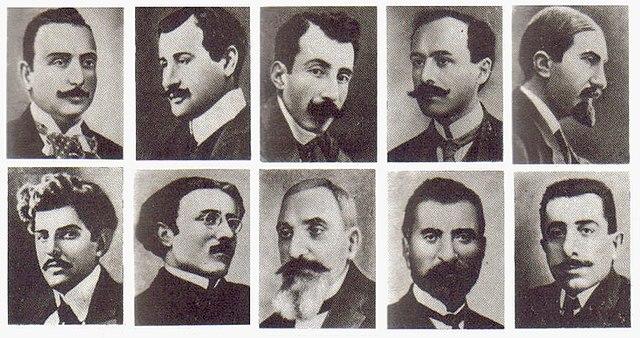
Deportation of Armenian intellectuals
The deportation of Armenian intellectuals is sometimes called Red Sunday. It is an operation organized during the Armenian Genocide, during which the leaders of the Armenian community in the capital of the Ottoman Empire, and later also the famous representatives of other communities of the empire, were arrested and transferred to two concentration places near Ankara, led by the order issued by the Minister of Interior Talaat Pasha.
In 1915 On April 24, K. Based on the orders of the Turkish authorities, more than two hundred Armenian intellectuals were arrested in Istanbul: writers, musicians, public speakers, lawyers, doctors, deputies, including deputies of the Turkish Parliament. On April 29, the number of those arrested reached 800, who were driven to the depths of Anatolia and brutally exterminated in Ayash, Çanghiri and a number of other places after unheard of torture. Arrested persons were driven into exile without trial and judgment, some of them died on the way to exile, the other on arrival. Writers Grigor Zohrap, Daniel Varuzhan, Siamanton, Ruben Zardaryan, Ruben Sevak, Artashes Harutyunyan, Tlkatintsi, Yerukhan, Tigran Chyokyuryan, Smbat Byurat, public speakers and editors Nazareth Tadavaryan, Tiran Kelekyan, Gagik Ozanyan and others became victims of the genocide.
Very few, including Vrtanes Papazyan and Komitas, were saved as a result of special intervention. The great Armenian songwriter Komitas, who, not being able to endure the severe mental experiences, went crazy, was returned to K. thanks to an influential intervention. Polis, a psychiatric hospital, and then Paris, where he died.
In June 1915, K. 20 prominent intellectuals of the Hnchakyan party were hanged in one of the squares of Istanbul. K. By destroying the Armenian intelligentsia in Istanbul, the Turkish authorities actually decapitated the Armenian population of Turkey. In May-June 1915, the mass deportation and massacre of the Armenian population of Western Armenia (Van, Erzurum, Bitlis, Kharberd, Sebastia, Diyarbakir provinces), Cilicia, Western Anatolia and other places began. The deportation of the Armenian population was already aimed at its destruction. They were all exiled and brutally killed.
The relative ease with which the Turkish exterminators managed to carry out the genocide of the Armenians of the Ottoman Empire is partially explained by the unpreparedness of the Armenian population, as well as the Armenian political parties, for the imminent threat of annihilation. The actions of the destroyers were also facilitated by the mobilization of the most combative part of the Armenian population, the men, as well as by K. With the elimination of the Polish intelligentsia. Obedience to the deportation order also played a certain role, because, according to some social and clerical circles of Western Armenians, disobedience would only increase the number of victims.
However, in some places, the Armenian population showed heroic resistance to the Turkish destroyers. The Armenians of Van, resorting to self-defense, successfully repelled the enemy's attacks and held the city in their hands until the approach of Russian troops and Armenian volunteers. The Armenians of Shapin Garahisar, Mush, Sassoon, and Shatakh showed armed resistance to the enemy's multiple superior forces. For forty days and nights, the truly epic battle of the defenders of Mount Musa in Sweden continued. The self-defense battles of the Armenians in 1915 are one of the heroic pages of the people's national liberation struggle and contributed to the salvation and survival of some part of the Armenian people.
The Armenian genocide was carried out by the ruling regions of Turkey. They are also responsible for that monstrous crime in the 20th century. are the culprits of the first genocide. The government of Imperial Germany, which was not only aware of the atrocity being prepared, but also contributed to its implementation, also bears its responsibility. The complicity of German imperialism was noted by advanced German intellectuals Y. Lepsius, A. Wegner, K. Liebknecht et al.
In fact, the destruction of Armenian intellectuals was part of a systematic, diabolical plan to annihilate the Armenian people in its cradle.
Add new comment